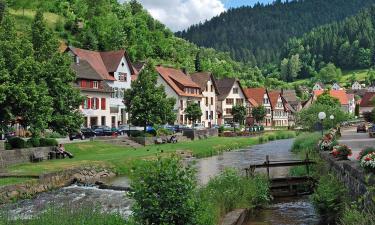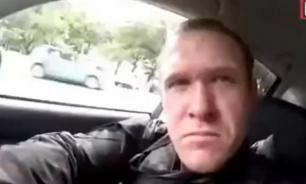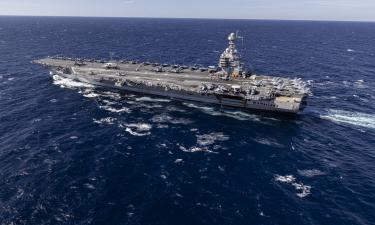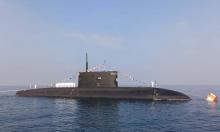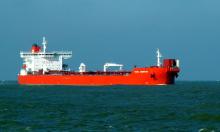Bill Clinton and George W. Bush start another Cold War against Russia
Francis Bacon once said that “he that gives good advice, builds with one hand; he that gives good counsel and example, builds with both; but he that gives good admonition and bad example, builds with one hand and pulls down with the other”.
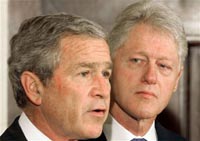
History of US-Russia relationship since the collapse of Soviet Socialist Republics (USSR) in 1991 is one of first building friendship with one hand then destroying it with the other. A close examination of available documents and US actions since the fall of USSR reveals how President Clinton and later President Bush, each in his own way, turned a major friendly power into almost an enemy.
Russia has historically been a major power in Europe. It has a population of 142 million. It is the largest country in the world by land mass. With an area of 17 million square kilometres, it is almost twice the size of the next-largest country, Canada. Russia has advance military technologies, enabling it to produce some of the most effective military products in the world. It is the world’s largest oil producer and it is close to the world’s largest oil reserves in the Middle East. It borders Japan, China, Middle East (through Caspian Sea) and EU.
Clinton and the Bad Advice
With the fall of the USSR, Russia went through a chaotic period. Its industries, economy and defence forces had to be restructured. Russians saw US as a friend; a country that they could form a lasting partnership with. Kremlin doors were opened wide to Washington. Russians, eager to improve their economy, were eager to embrace new ideas. Who better to show them the way than the leader of the “capitalist world”. So when the United States offered advice they accepted it wholeheartedly. But as history shows those advices almost ruined the Russian Federation and caused immense hardship to the Russian people.
In 2000, the extent of the American contribution to the Russian economic decline became clear. A report commissioned by the United States House of Representatives and produced by the leaders of six committees of the House, produced a comprehensive picture of Clinton Administration’s involvement in creating a system of corruption and oligarchy in Russia. The report listed a number of “mistakes” by the Clinton administration in its dealing with Russia. Some of those “wrong policies” are listed bellow.
“A strong preference for strengthening Russia's central government, rather than deconstructing the Soviet state and building from scratch a system of free enterprise;
A close personal association with a few Russian officials, even after they became corrupt, instead of a consistent and principled approach to policy that transcended personalities;
A narrow focus on the Russian executive branch to the near exclusion of the Russian legislature, regional governments, and private organizations;
An arrogance toward Russia's nascent democratic constituencies that led to attempts at democratic ends through decidedly non-democratic means;
An unwillingness to let facts guide policy, or even to make mid-course corrections in light of increasing corruption and mounting evidence of the failure of their policies
By focusing on strengthening the finances of the Russian government and on transforming state-owned monopolies into private monopolies, instead of building the fundamentals of a free enterprise system, the Clinton administration ensured that billions in Western economic assistance to Russia would amount to mere temporizing. The Gore-Talbott-Summers focus--on macro-management of the Russian economy instead of the legal fundamentals that would permit individuals to start businesses, grow a competitive market economy, and create a tax base--doomed their "privatization" efforts to failure.
Worse, by using massive lending and aid to plug the gap in the Russian central government's operating budget, the Clinton administration exposed these funds to theft and fraud”.
Of course by the end of Yeltsin administration situation had become so critical that nothing short of a major restructuring of the system could stabilise the situation. Putin was the right man for the job. He started by restricting the activities of the oligarchs and stopped the corrupt and uncontrolled “privatisation”. But the damage that was done under Yeltsin was enormous and will take many decades to repair.
By the end of the Yeltsin presidency, the Russian people had lost all faith in the capitalist system. The ordinary people often equated privatisation with theft. As ordinary hard working Russians struggled to keep themselves warm in the harsh winters, the rich spent astronomical amounts on luxury yachts and villas abroad.
By encouraging uncontrolled privatisation, wholesale auctioning of important government assets to a few corrupt friends, excessive borrowing, opening local markets to imports, etc, Clinton Administrationwas destroying the Russianeconomy. All considered, the Clinton era “intervention” in Russia can be called disastrous for Russia. How much of these “mistakes” were by design and how much it honest mistakes, we don’t know. But one thing is sure; the Russians have learned a very good lesson.
The Road to Cold War II
The history of the Neocons is well known. Neocons are a group of people bent on making the US the sole hegemon of the world. Barely a year after the collapse of the USSR, this group published its plan on how the sole superpower should act. The Defence Policy Guidance, crafted by the then-Defence Department staffers I. Lewis Libby and Paul Wolfowitz at the behest of Defence Secretary Dick Cheney set the agenda for the new world order.
“Our first objective is to prevent the re-emergence of a new rival. This is a dominant consideration underlying the new regional defence strategy and requires that we endeavour to prevent any hostile power from dominating a region whose resources would, under consolidated control, be sufficient to generate global power. These regions include Western Europe, East Asia, the territory of the former Soviet Union, and Southwest Asia. There are three additional aspects to this objective: First the U.S must show the leadership necessary to establish and protect a new order that holds the promise of convincing potential competitors that they need not aspire to a greater role or pursue a more aggressive posture to protect their legitimate interests. Second, in the non-defence areas, we must account sufficiently for the interests of the advanced industrial nations to discourage them from challenging our leadership or seeking to overturn the established political and economic order. Finally, we must maintain the mechanisms for deterring potential competitors from even aspiring to a larger regional or global role.”
The election of George W. Bush gave these people real power but not the opportunity to implement their plans. The 9/11 attack on the US provided the perfect opportunity and excuse. Soon after, they set about trying to deal with the perceived future challenges to the US power.
One of those countries that have historically managed to challenge others for supremacy in its region is Russia. This made Russia a natural target for Neocons. It didn’t matter if Russia was friendly or not. Russia had the capacity and desire to become a global power again. If not now, then perhaps later it would.
When Vladimir Vladimirovich Putin took over the Russian Presidency in December 1999, Russian economy was on the verge of collapse. The oligarchs were in control of many important sectors of the economy and were trying to extend their control even further. Those in Yeltsin’s administration had hoped that by helping Putin they could control him. But Putin, a former KGB officer and the first civilian head of SFB (former KGB) had many other friends, such as the Siloviks (nationalists from military and various powerful ministries who define themselves as defenders of Russian national interest). Siloviks provided Putin with a counter-balance to the oligarchs. With their backing, Putin began to reassert the central government’s control over the country.
As Putin began his struggle to stabilise the country, the US began expanding NATO. In March 1999, Czech Republic, Hungary and Poland joined NATO. NATO was created in 1949 as (unofficially) a defence alliance against USSR and was limited geographically to the Euro-Atlantic regions of the Northern hemisphere. By late 1990s, with that threat gone, the talk across the Europe was about the slow death of NATO. Since Russia did not threaten to invade any of these countries, there was no reason for expanding NATO into Eastern Europe, so we thought. Russia under Yeltsin was in the process of extreme decline and on the verge of bankruptcy.
Russians of course saw this expansion as a threat but since they were hardly in a position to stop it, reluctantly accepted it. Then came the 9/11 and the war on terror. After 9/11, United States began to establish a number of “temporary” bases in Russia’s “backyard” in the Caucasus. US placed troops in Georgia, Uzbekistan, Tajikistan and Kazakhstan. Once the invasion of Afghanistan was over, US began the preparation for the invasion of Iraq, a Russian ally. By this time the Russians were worried that US not only was going to turn their temporary bases into permanent ones but also trying to become a hegemon in the region as well. They tried their utmost to stop the invasion of Iraq but failed to stop the US from achieving its objectives.
To be continued
Dr. Abbas Bakhtiar
Dr. Abbas Bakhtiar lives in Norway. He is a consultant and a contributing writer for many online journals. He's a former associate professor of Nordland University, Norway. Bakhtiarspace-articles@yahoo.no
Subscribe to Pravda.Ru Telegram channel, Facebook, RSS!

